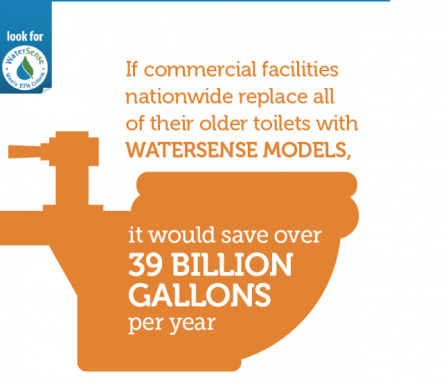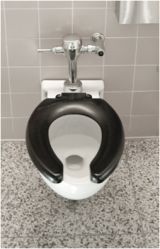Commercial Toilets

![]() Commercial toilets, or flushometer-valve toilets, are typically found in commercial, institutional, or industrial restrooms in such places as airports, theaters, stadiums, schools, and office buildings. These types of toilets have two main components—the toilet bowl and the flushometer valve.
Commercial toilets, or flushometer-valve toilets, are typically found in commercial, institutional, or industrial restrooms in such places as airports, theaters, stadiums, schools, and office buildings. These types of toilets have two main components—the toilet bowl and the flushometer valve.
On This Page:
Smart Flushing
WaterSense estimates that there are nearly 27 million flushometer-valve toilets currently installed in the United States. Approximately 26 percent (7 million) of the old toilets have flush volumes as high as 3.0 to 7.0 gallons per flush (gpf)—far more water than the federal standard of 1.6 gpf. With many of these models reaching the end of their useful life, replacing them with even more efficient toilets that have earned the WaterSense label could result in significant water savings.
WaterSense labeled flushometer-valve toilets, whether single- or dual-flush, use no more than 1.28 gpf, which is a 20 percent savings over the federal standard of 1.6 gpf. WaterSense has also included a minimum flush volume of 1.0 gpf to ensure plumbing systems have adequate flow to function effectively.
Whether you are looking to reduce water use in a new facility or replace old, inefficient toilets in commercial restrooms, a WaterSense labeled flushometer-valve toilet is a high-performance, water-efficient option worth considering.
Facility managers should consult a plumbing engineer if they have questions about using WaterSense labeled flushometer-valve toilets in their buildings. Like all WaterSense labeled products, the toilets are also required to be independently certified for performance to ensure they can handle typical commercial waste loads.
A WaterSense Flushometer-Valve Toilets fact sheet(1 pp, 690 K, About PDF) is available in PDF.
WaterSense Savings
 By replacing old, inefficient flushometer-valve toilets with WaterSense labeled models, a 10-story office building with 1,000 occupants could save nearly 1.2 million gallons of water and nearly $10,000 per year. Of those savings, nearly 870,000 gallons of water and $7,600 in water costs per year can be achieved by replacing the toilets in the women's restrooms alone.
By replacing old, inefficient flushometer-valve toilets with WaterSense labeled models, a 10-story office building with 1,000 occupants could save nearly 1.2 million gallons of water and nearly $10,000 per year. Of those savings, nearly 870,000 gallons of water and $7,600 in water costs per year can be achieved by replacing the toilets in the women's restrooms alone.
If commercial facilities nationwide replaced all of their older, inefficient flushometer-valve toilets with WaterSense labeled models, it could save an estimated 39 billion gallons of water per year. That’s equivalent to nearly one full day’s flow of water over Niagara Falls!
Specification
Flushometer valve toilets are also known as flushometer-valve water closets in plumbing standards. EPA released a final specification for flushometer-valve water closets on December 17, 2015.
- WaterSense Specification for Flushometer-Valve Water Closets (PDF)(6 pg, 242K, About PDF)
- WaterSense Specification for Flushometer-Valve Water Closets Supporting Statement (PDF)(12 pg, 299K, About PDF)
For more information about the flushometer-valve toilets specification development process, including the draft specification, public response to the draft specification, EPA's response to the public comments, and questions and answers, please see the Specification for Flushometer-Valve Toilets Background Materials page.
Manufacturers that produce toilet fixtures and flushometer valves meeting EPA's efficiency and performance criteria can apply to have their products certified to earn the WaterSense label. Before submitting products for testing, manufacturers must have a partnership agreement with EPA in place. Visit the manufacturer section on the partner page to learn more.


